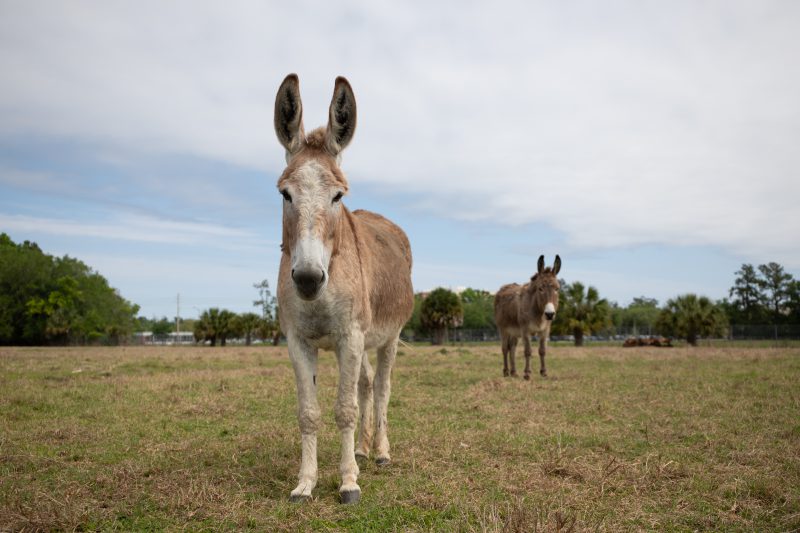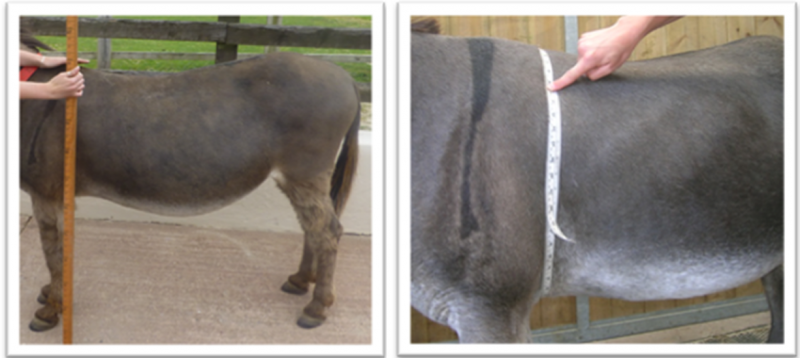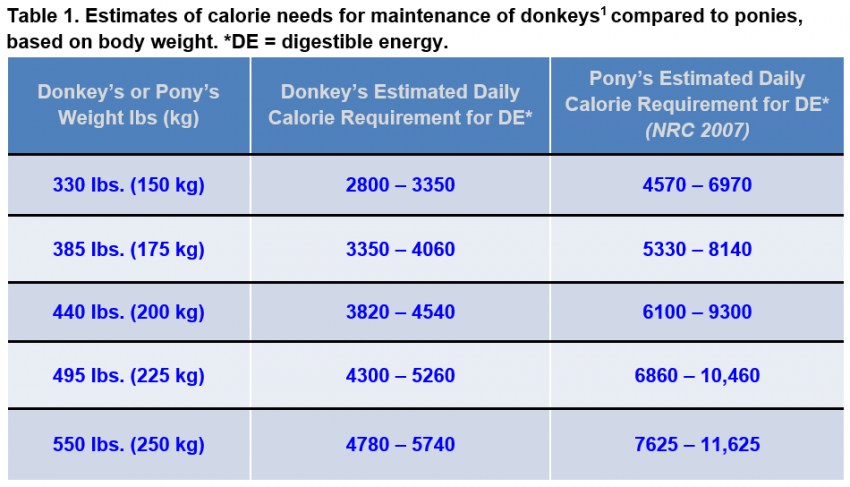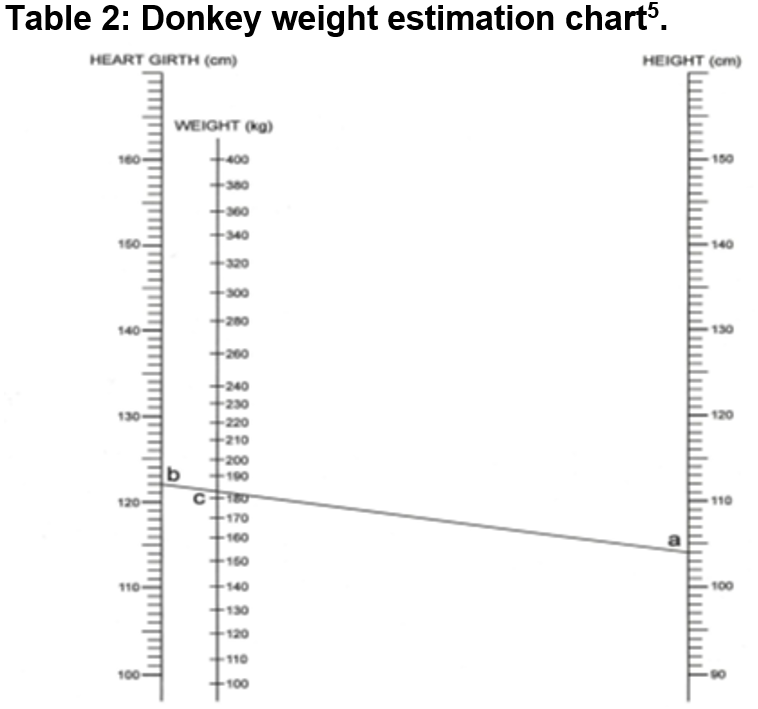
Donkeys are more efficient than horses. They generally don’t require grain concentrates to maintain body weight when they have adequate access to moderate quality forage . Photo credit: Cristina Carriz, UF/IFAS
Dr. Carissa Wickens, UF/IFAS, Department of Animal Sciences and Dr. Nettie Liburt, Mars Horsecare, BUCKEYE™ Nutrition
Donkeys evolved in desert areas and were well adapted to grazing poor-quality forages. Ancestors of donkeys consumed high fiber, low energy plants over the course of 14-18 hours per day, while roaming up to 18 miles1. Today, domestic donkeys living in temperate climates, such as North America, generally have access to good quality forage, and plenty of it, placing them at risk for gaining too much weight, laminitis and hyperlipemia1 (too much fat circulating in the blood). Thus, careful management is necessary.
–
Donkey Nutrition and Feeding Guidelines
While the donkey and the horse have a digestive tract that is similar in structure and function, donkeys have enhanced digestive efficiency. Donkeys tend to retain fiber for a longer period to maximize digestion, which can sometimes lead to a hay belly appearance1. Donkeys, like horses, are hindgut fermenters, but have only 50-75% of the energy (a.k.a. calorie) requirements compared to ponies of similar size and weight, as shown in Table 11. Donkeys consume about 1.3-1.8% of their body weight in feed (on a dry matter basis), compared to horses who consume closer to 2-2.5%1.
There is limited research on the vitamin and mineral requirements of donkeys, though current minimum recommendations for horses seem suitable for donkeys1. Providing donkeys access to a trace mineral salt block is recommended.
Fibrous forage is the basis for a donkey’s healthy diet. Lower quality forage, that may be too mature for a horse, is often just fine for a donkey. Donkeys typically don’t need grain concentrates, nor are they generally recommended2. Starch and sugar should also be kept low, making up 15% or less of a donkey’s total daily intake2. Donkeys enjoy shrubs and browse; just be sure the plants are safe and non-toxic. Examples of safe plants include ash, poplar, lime, hawthorne, alder, apple trees and gorse2. These plant varieties (along with bananas, chopped apples, carrots, or mint leaves)1 can also be used to tempt a donkey who seems to have lost their appetite. If a donkey refuses to eat, you should contact a veterinarian immediately. Anorexia can put donkeys at risk for hyperlipemia, a potentially fatal condition.
If a donkey does need additional calories, it is best to supply calories from forage sources. Examples include beet pulp, hay pellets or chopped hay1. In some cases, moderate amounts of a fat supplement are acceptable as well1. The more fiber is consumed, the more water becomes important. Water is a crucial component of any healthy donkey’s diet. Donkeys tend to prefer warmer water (about 59°F or more). Donkeys are adapted to cope with thirst and rapid rehydration, but require a similar amount of water as horses do (5-15 gallons, depending on size, weather, and workload)2. Plenty of fresh, clean water should always be available.
–
Body condition scoring for donkeys
Weight monitoring is very important for donkeys, but the Body Conditioning Scoring system is different for donkeys and horses. Horses are typically scored from 1-9, based on the Henneke Body Condition Scoring System4. Donkeys are scored from 1-5, based on a system developed by The Donkey Sanctuary in the UK5. A score of 1 indicates an emaciated donkey in need of medical and nutritional intervention; ribs, hips and vertebrae would be easily seen with very little fat cover5. A score of 3 is ideal, with ribs and vertebrae easily felt, but not seen5. A score of 5 would indicate an obese donkey, likely with fat pads and a cresty neck5. It is not sufficient to simply look at a donkey to assess condition. Instead, it is essential to feel the neck, ribs, shoulder, rump, etc. Muscle feels firm, and fat feels more sponge-like. Donkeys deposit fat differently than horses, which is one reason a scoring system specifically for donkeys is necessary.

Left: Measuring a donkey’s height. Right: Measuring heart girth. Photos courtesy of The Donkey Sanctuary5.
–
Along with body condition, it is important to monitor weight. There are some simple ways to estimate a donkey’s weight. You’ll need a long tailor’s tape. Measure the donkey’s heart girth in centimeters (cm), just behind the shoulders, while the donkey is standing square on a level surface5. Next, measure the donkey’s length from the elbow to the pin bone (point on the rump, next to the tail; forms a rounded point). Finally, measure the donkey’s height at the withers. Weight can be estimated using the following equation6:
Weight in kilograms = [(heart girth in cm)2.12 x (length in cm)0.688] / 3801
–
If a donkey has a high body condition score (in other words, if a donkey is fat with a BCS of 4 or 5), another equation may estimate weight better6:
Weight in kilograms = [(heart girth in cm)2.575 x (height at the withers in cm)0.240] / 3968
–
The Donkey Sanctuary has also developed a chart that can be used to estimate a donkey’s weight5 (Table 2), where (a) is the measurement of height at the withers in cm, and (b) is the measurement of heart girth in centimeters (cm). Use a ruler to draw a straight line to connect points a and b. Where the line intersects the column labeled weight (c), that is the donkey’s estimated weight in kilograms.
–
It is important to regularly monitor weight and body condition. Keep a log and set a schedule, such as each time the donkey’s hooves get trimmed, or the 1st of each month. In this way, any changes in weight can be recorded and diet can be adjusted if necessary.
–
General Considerations and Tips for the Care and Management of Donkeys
Donkeys are not simply “small horses.” While donkeys and horses share the same genus, “Equus,” they are not the same species. Donkeys and horses differ in basic physiological measurements of temperature, pulse, and respiration (Table 3.)
Exercise is beneficial for your donkey, especially if weight management is a concern. Donkeys should have ample space to be turned out. In addition, placing toys in paddocks not only provides enrichment, but encourages donkeys to move around and play. Spreading hay around areas of turnout also encourages movement. Teaching donkeys to drive and pull carts is a fun and interactive way to increase exercise, and even to get to know your donkey better. Ensure proper training methods and well-fitting equipment to avoid injury to the donkey or the handler. Even light to moderate exercise will increase energy expenditure and help maintain muscle tone, both of which have health benefits.
–
Take Home Message
Donkeys require fewer calories than horses do to maintain weight, and generally do not need commercial grain concentrates made for horses. Instead, a ration balancer can provide vitamins and minerals to ensure needs are met without providing unnecessary calories. A donkey’s diet should be made up of moderate quality forage that allows them to chew and browse. Exercise and enrichment are key factors in overall donkey health, so consider bringing your donkey along on your next trail ride or other adventure. Monitor weight regularly and seek the help of a qualified nutritionist, if you are unsure of how to balance your donkey’s diet.
–
Further Reading
The Donkey Sanctuary, Knowledge & Advice webpage
The Donkey Sanctuary, Feeding Donkeys
The Donkey Sanctuary, Body Condition Score Chart
References
- Smith, D. & Burden, F. 2013. Practical donkey and mule nutrition. In: Equine applied & clinical nutrition. Saunders Elsevier, United Kingdom. pp 304-316.
- Burden, F. & Thieman, A. 2015. Donkeys are Different. Journal of Equine Veterinary Science, 35: 376-382.
- Liburt, N., Williams, C. & Malinowski, K. 2016. Rutgers University Cooperative Extension Fact Sheet FS1262
- Henneke, D., Potter, G., Kreider, J & Yeates, B. 1983. A scoring system for comparing body condition in horses. Equine Veterinary Journal.
- The Donkey Sanctuary. 2014. Condition scoring and weight estimation.
- Pearson, R.A. & Ouassat, M. 2000. A guide to live weight estimation and body condition scoring of donkeys. Center for Tropical Veterinary Medicine, University of Edinburgh.



